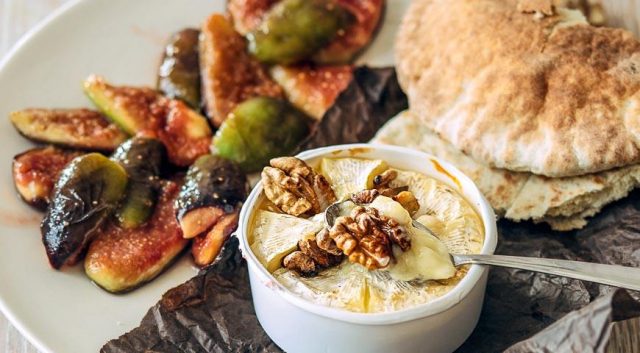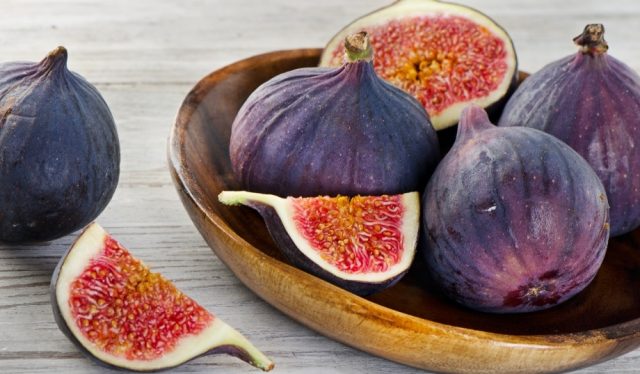Content
The introduction of figs into the diet helps to replenish the supply of useful elements in the body. For this purpose, the fruit of the fig tree is consumed both fresh and dried. The benefits and harms of figs for the body cause a lot of controversy. Despite the richness of nutrients, the use of the product is carried out taking into account all the nuances.
Figs are a fruit or a berry
Figs are also popularly called figs and figs. Due to its ambiguous appearance, it is not easy to classify. The high seed content suggests that the fig is a berry. However, unlike other berries, the fig tree grows on trees. Officially, it is classified as an inflorescence. The tree on which it grows is considered to be a representative of dicotyledonous flowering plants.
Figs are distinguished by a dense, but thin peel, and an oval shape. The ripe fruit has a dark purple skin and reddish contents. A distinctive feature is a sweet taste with a slight sourness. Figs are harvested at the end of June and between September and October. The fig tree bears fruit twice a year.
Fig composition
The benefits of figs for the human body cannot be overestimated. It is considered the leader in the content of minerals and vitamins. It is also appreciated for the presence of fiber in the composition, which carries out the absorption of toxins. Thanks to the niacin content, the product supplies the brain cells with the right amount of oxygen. Subsequently, cerebral circulation improves and the frequency of headaches decreases. When consumed regularly, figs restore metabolism and improve the conductivity of nerve cells. The composition of the product is represented by the following components:
- folic acid;
- magnesium;
- vitamins B, PP, A and C;
- potassium;
- phosphorus;
- sodium;
- iron;
- calcium.
Why figs are useful for the human body
The fruit of the fig tree is high in value. On Russian counters, they are less common than other fruits and berries. This further enhances their value. The beneficial properties of the product help to resist the body in times of crisis. Eating figs is a good way to replenish your supply of minerals and vitamins. The benefits of the product are explained by the following features:
- increasing the strength of bone tissue;
- strengthening the walls of blood vessels;
- activation of the body's defenses;
- preventing dehydration and eliminating severe thirst;
- decrease in low-grade fever;
- elimination of stress symptoms;
- cleansing from toxins;
- help with dry type of cough;
- antiparasitic action;
- acceleration of skin regeneration;
- decreased appetite and normalization of metabolic processes.
Figs are an irreplaceable food product during weight loss. Thanks to its nutritional properties, it helps control appetite. It is often used for snacks. The laxative effect of the fig tree provides a high-quality bowel cleansing. Due to the elimination of excess fluid, the appearance of edema is prevented. It helps to get rid of a couple of pounds.In addition, the product helps to replenish the lack of serotonin, which is typical during weight loss.
Figs are in demand in cooking. It gives the dishes a sweet, piquant taste. The product goes well with almost any type of meat. Delicious desserts are made from it. With dietary nutrition, the fig tree is often used to enrich vegetable salads.
Why figs are useful for a woman's body
The fig tree should be present in the diet of every woman who is not indifferent to her health. As a source of nutrients, the product is especially appreciated in preparation for pregnancy and during gestation. In addition, the product has a positive effect on the condition of the skin, which makes a woman more attractive.
The useful properties and contraindications of figs for women should be studied as carefully as possible. This will prevent unexpected body reactions and get the most benefit. The main beneficial properties of the product for women include:
- prevention of diseases of the urinary system;
- antioxidant action;
- control of body weight;
- elimination of endocrine disorders;
- slowing down the aging process;
- improving the condition of the skin;
- calming effect in the premenstrual period.
Gynecologists recommend introducing figs into the diet of women with irregular cycles. The diet is combined with medication and physiotherapy. The substances that make up the fruit contribute to the production of a healthy egg and the uniform growth of the endometrial layers. This is due to the vitamin composition of the product. Its introduction into the diet helps to get rid of severe pain during menstruation and normalize the psychological state.
Why figs are useful during pregnancy
During pregnancy, figs are allowed to be consumed only by those women who are not predisposed to an allergic reaction. It is one of the richest sources of folate. This substance is necessary for a child during intrauterine development. Folic acid is responsible for the formation of the neural tube. A sufficient amount of it in the diet reduces the risk of fetal pathologies.
When used correctly, figs can be a good alternative to multivitamin complexes. Its advantages include natural origin. It is very important not to exceed the daily allowance in order to avoid a vitamin surplus. During pregnancy, there is an increased likelihood of stool disturbance. Due to its high fiber content, fig normalizes stool without negatively affecting the digestive organs. Due to the presence of iron in the composition, figs prevent iron deficiency anemia, to which women in position are prone.
What is useful for men
The benefits and harms of figs for men are controversial. One of the important properties of the product is considered to stimulate erectile function. The fig tree is a powerful aphrodisiac. Unlike medications, it is absolutely safe for health. Due to the abundance of nutrients, it prevents the development of prostate diseases, which is important for men who are over 40 years old. When consumed regularly, figs can reduce the risk of developing Alzheimer's disease and atherosclerosis.
What is useful for children
Experts recommend introducing figs into the diet of a child from 9 months. At an earlier age, the enzymes responsible for processing the product are not yet available. For the first time, give no more than 0.5 tsp. dried fig trees. It is preliminarily softened with boiling water, and then crushed until smooth. At this stage, it is important to monitor the reaction of the child's body. Allergy symptoms indicate the need to remove figs from the diet. It is imperative that you visit your pediatrician beforehand. He will determine the possibility of using the product on an individual basis.
It is not recommended to give figs to your child every day.It is necessary to dose its use. In this case, the following effect on the body is produced:
- antipyretic effect;
- laxative effect;
- strengthening the immune system;
- hepatoprotective effect;
- improvement of intestinal motility;
- prevention of anemia.
Figs for breastfeeding
The product is also useful during breastfeeding. It ensures that the baby receives the required amount of nutrients in the milk. Doctors recommend introducing it into the diet already during gestation. In this case, the adaptation to the new product will be more comfortable. After giving birth, figs are allowed to be consumed no earlier than 2 months later.
The benefits of figs for women are to prevent swelling. This is due to the potassium content. It promotes the elimination of excess fluid from the body. During lactation, the female body withstands the load. The likelihood of developing new diseases and exacerbation of existing ones increases. Figs replenish the supply of vitamins, strengthening all life support systems.
The first experience of introducing figs into a woman's diet is carried out in the morning, before feeding. During the day, the newly-made mother monitors the baby's condition. If there are no negative reactions, the amount of the product can be increased the next day. But this does not mean that you can lose your vigilance. Allergen reactions can be cumulative. Therefore, you should constantly monitor the condition of the child.
Is it possible to use figs for diabetes
It is necessary to find out whether figs can be used in diabetes mellitus on an individual basis. When consumed in moderation in the early stages of the disease, it has no harmful effects. Due to the content of pectin, there is a positive effect on the patient's well-being. Fiber helps control the amount of bad cholesterol in the blood.
Figs for type 2 diabetes are allowed to be consumed in limited quantities. It must be remembered that 1 fruit with a mass of 85 g contains 1 bread unit. At stages 3 and 4 of the disease, the product cannot be included in the diet. In this case, the patient often develops wounds, abrasions and sores on the skin. The ficin content in figs has a thinning effect on the blood. This inhibits the regenerative processes. Abuse of fig trees is dangerous and increases blood sugar levels. This worsens the patient's condition.
How to eat figs: with or without skin
People who have recently discovered a fig tree do not know how to properly eat it. It is customary to eat it along with the peel and bones. Throw out only the branch located at the base. Some varieties of figs have thick rind. In this case, it is better to get rid of it, as it may be difficult to chew. When setting the table, the fig tree is cut into slices and laid out with the inner side up. For children, the product is crushed to a puree state.
Experts advise eating figs with dairy products. This contributes to the good digestibility of useful components. When paired with cheese, it can be a good holiday snack option. It is advisable to eat the product in the morning - for breakfast with oatmeal or as part of milkshakes. As a snack, it is used in combination with low-fat cottage cheese. This option is perfect for people involved in sports.
Calorie content of figs
Compared to sweet desserts, the fig tree has a lower calorie content. Therefore, it is eaten by people who set themselves the goal of losing weight. But, if you consume the fruits in large quantities, you can achieve the opposite effect. The calorie content of fresh figs is 54 kcal per 100 g. The calorie content of a dried fig tree is higher, since sugar syrup is used in its preparation.100 g of dried fruit contains 257 kcal.
Contraindications
Any product, depending on the observance of the principles of its use, can both harm and provide benefits. Therefore, it is important to study contraindications. This will help avoid allergies and other side effects. The health benefits and harms of figs will vary from case to case. Contraindications include:
- high blood pressure;
- all forms of pancreatitis;
- upset stool;
- stones in the kidneys;
- individual intolerance to figs;
- the last stages of obesity;
- exacerbation of chronic gastrointestinal diseases;
- gout.
Excessive consumption of the fig tree in food can provoke abdominal discomfort, accompanied by loose stools. In some cases, there is an increase in blood pressure. People with thinned enamel have a toothache. If signs of an allergic reaction appear, the fig tree should be discarded. In order not to bring the situation to Quincke's edema, it is necessary to drink an antihistamine. After this, it is extremely important to see your doctor.
Terms and conditions of storage
Figs are classified as exotic foods. Fresh, in stores it can be found in the fall. At other times, it is advisable to buy the product in dried form. It is not inferior to fresh fruits in nutritional value and content of useful components. The most optimal temperature for storing fresh figs is 1 to 3 ° C. The most suitable place for storage is the refrigerator. In order for the product to retain its beneficial properties for a longer time and does not absorb foreign odors, it is wrapped in paper or placed in a container. The shelf life of the product under all conditions is 4 days.
Unripe fruits can reach the desired state at home. Putting them in the refrigerator is strictly prohibited. It is advisable to remove the fruits in a dark place with a cool temperature. A pantry or basement is perfect for ripening. The ripening process takes on average 2-3 days.
Dried figs last longer than fresh ones. It is placed in the refrigerator without removing it from the packaging in which it was sold. For long-term storage, it is necessary to regularly sort out figs for spoiled fruits. You should get rid of them. If this is not done, then the shelf life will be reduced. The most suitable container for storing dried figs is a glass jar with a tight-fitting lid.
Another way to store a fig tree is to harvest it for the winter. Jams, preserves, marshmallows and homemade wine are made from it. But it must be borne in mind that the content of nutrients and the calorie content of the product in this case will change. In diabetes mellitus, this variant of the use of the fig tree is contraindicated. The storage period for the workpieces is several years. When frozen, figs can retain their properties for about a year. Freezing is carried out at a temperature of -15 ° C.
Conclusion
The benefits and harms of figs for the body should be known to everyone. The product skillfully combines the role of a treat and a remedy. When used correctly, it can help prevent various diseases and get rid of existing problems.











